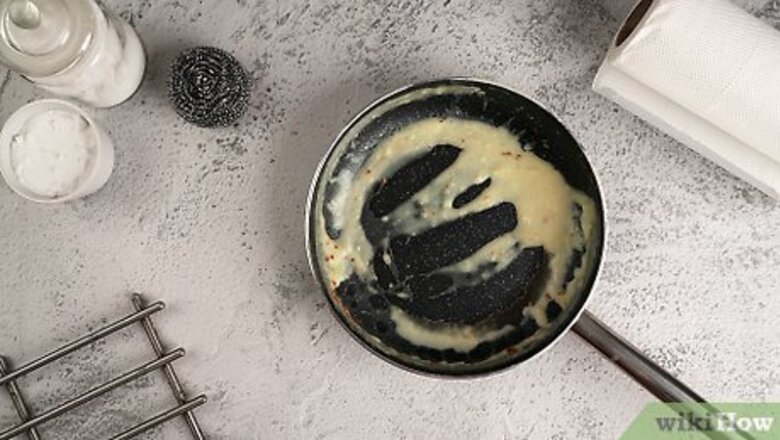
views
- Let ceramic pans cool down to room temp before cleaning them.
- Use lightly abrasive cleaning products to tackle scuffs and scratches.
- Scrub pans down with a non-scratch sponge or a microfiber cloth.
- Take preventative action to keep your ceramic pans in great shape.
Let your ceramic pan cool first.
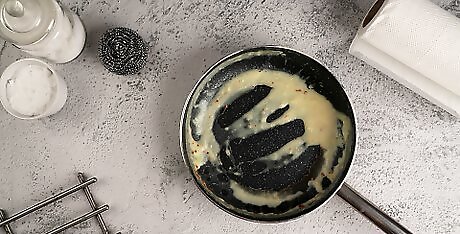
Avoid warping or cracking by letting your pan return to room temp. Take your ceramic pan off the stove and set it on a counter or a placemat. Wait about 10-15 minutes. When you give your pan some time to gradually cool off, it won’t shatter from “thermal shock” because of an extreme temperature change.
Wash your ceramic pan with soapy water.
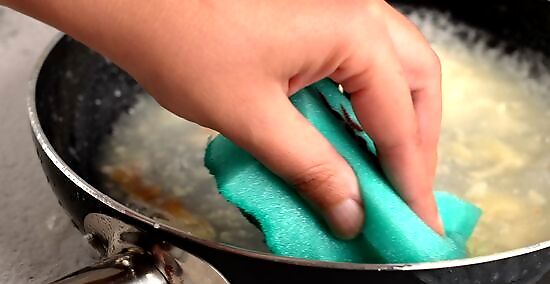
Dissolve oil and food with just a couple drops of dish soap. Take out some mild dish detergent and pour 3-4 drops onto the pan. Add just a small amount of warm water and wipe down any grime or crust with a non-scratch scrub sponge. Leave the soapy water in your pan for 15 minutes, then rinse it out.
Use baking soda to clean off food particles.
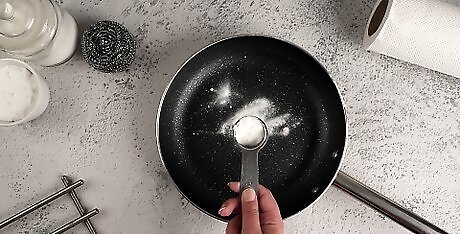
Reach for baking soda since it’s mildly abrasive and breaks down crud. If you’ve got a lot of burnt residue from meals on your pan, grab your baking soda. Drizzle about 2 tbsp (28.3 g) of the baking soda onto all the dirty spots on your pan. Wait 25 minutes. Then, dampen a non-scratch scrub sponge. Using circular motions, work it into all the stains to clean them. Rinse with water and repeat if necessary. Alternatively, you can create a mixture of baking soda and vinegar and gently scrub the stains with this paste, using a towel or a microfiber cloth.
Buff off mild stains with some salt.
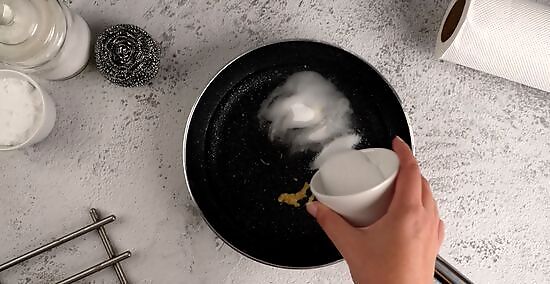
Drizzle salt over greasy spots since it's such a great scrubbing agent. Pour warm water into your pan and add a generous amount of salt—about 5-6 tbsp (70.87 g) works. Wait 20-30 minutes. Then, add 2-3 drops of mild dish detergent. Rub down your pan with a non-scratch scrub sponge.
Scrub away tough stains with white vinegar.
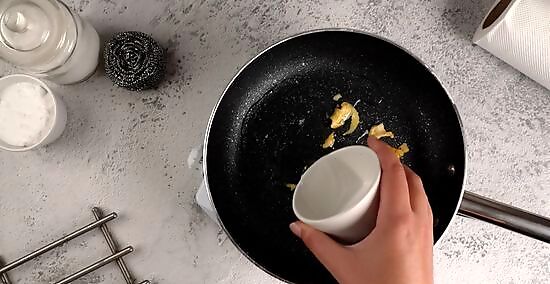
Combine vinegar and water to make an acidic mix that fights buildup. Scrape off large chunks of burnt food with a rubber spatula. Then, mix a solution that's 1 part white vinegar to 4 parts warm water. Pour the mix into your pan and place it on the stove over medium-high heat. Let the solution boil for 3-4 minutes. Turn off the heat and let the pan return to room temp. Scrub down the pan with a soft sponge.
Lighten dark stains with hydrogen peroxide.
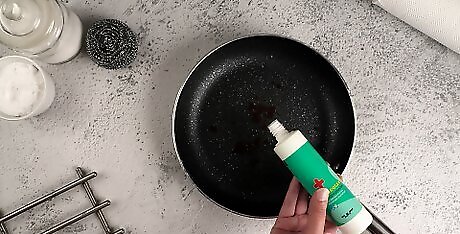
Erase scorch marks with the bleaching power of hydrogen peroxide. Pour about 1 inch (2.5 cm) of 3% hydrogen peroxide into your pan. Check to see if the spots and scorch marks are bubbling—that’s a sign that the chemical reaction is working. Wait 30 minutes for the hydrogen peroxide to break up dark stains. Rub down the dissolved stains with a microfiber cloth to clean them off.
Remove scuff marks with a powdered cleanser.
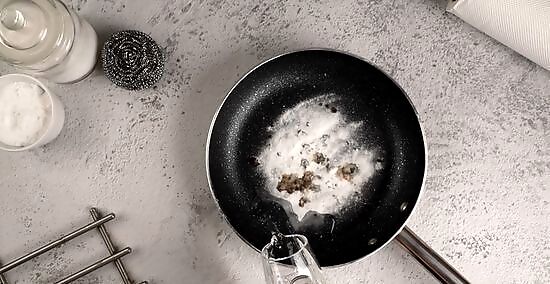
Rub away scratches with the abrasive minerals in oxalic acid powder. Try a brand like Bar Keeper’s Friend. Pour enough water into the pan to coat it. Then, sprinkle in 2-3 shakes of oxalic acid powder. Wait about 10 minutes. Gently buff out the stains with a non-scratch sponge or microfiber cloth.
Loosen up grit and grease with a dryer sheet.
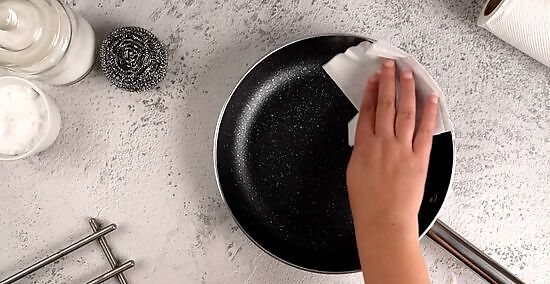
Soften grimy particles with the chemicals in a dryer sheet. Place 1 dryer sheet at the bottom of your ceramic pan. Then, pour about 1 cup (240 mL) of hot water over the dryer sheet to submerge it. Wait 3 hours. Drain the dirty water from your pan, let it air dry for 24 hours, then give it a good rinse.
Tackle grease buildup with an enzyme cleaner.
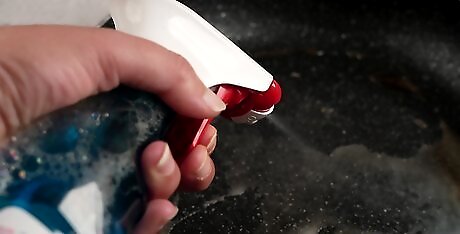
Break down crust with the chemical reaction from an enzyme cleaner. Grab a spray bottle of enzyme cleaner and spritz all the oily stains or burnt food on your pan. Wait 3 minutes for the enzymes to dissolve the residue. Dampen a non-scratch sponge with water and dish soap, then wipe everything down. Dry your pan with a microfiber cloth.
Take preventive action to maintain your pans.
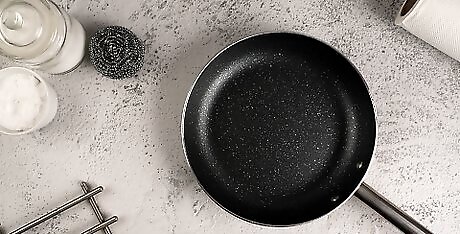
With some TLC, your pans will look brand-new for years to come. They’re definitely worth the effort! Since ceramic pans don’t have any chemical additives and they don’t need much oil when you’re cooking, they’re a great staple in your kitchen. In order to keep your ceramic pans in their best shape, make sure to: Use plastic, wood, nylon, or silicone utensils to avoid scratches. Place empty pans on very low heat so you don’t scorch them. Turn on very low heat if you cook food without liquid so it doesn't burn. Store your ceramic pans carefully so other cookware don’t scuff them. Season your pans with oil to restore their nonstick qualities.

















Comments
0 comment